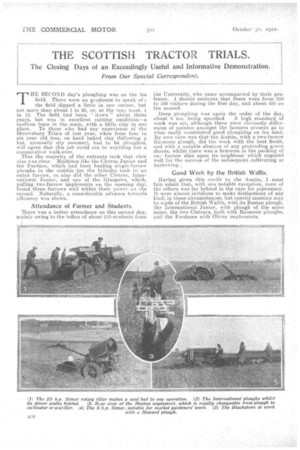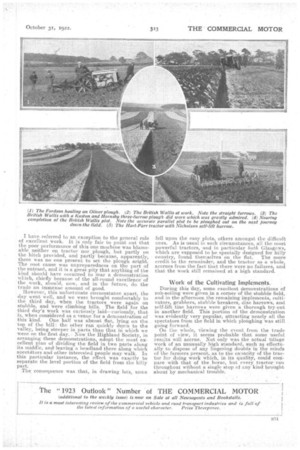THE SCOTTISH TRACTOR TRIALS.
Page 14

Page 15

If you've noticed an error in this article please click here to report it so we can fix it.
The Closing Days of an Exceedingly Useful and Informative Demonstration. From Our Special Correspondent.
THE SECOND day's ploughing was on the lea field. There were no gradients" to speak of ; the field dipped a little in one corner, but not more than about 1 in 20, or, at the very most, 1 in 15. The fielil had been " down " about three years, but was in excellent cutting condition—a medium loam in the main, with a little clay in one place. To those who had any experience of the Shrewsbury Trials of last year, when froth four to six year old leas, on hard baked clay (following a hot, unusually dry summer), had to be ploughed, will agree that this job could not be anything but a comparative walk-over.
That the majority of the entrants took that view also was clear. Machines like the Clotrac Junior and the Fordson, which had been hauling single-furrow ploughs in the stubble (on the hillside) took in an extra furrow, as also did the other Cletrac, International Junior, and one of the Glasgows, which, pulling two-furrow implements on the opening day, found three furrows well within their power on the second. Naturally, a considerable advance towards efficiency was shown.
Attendance of Farmer and Students.
Mere was A better attendance on this second day, mainly owing to the influx of about 130 students from
the University, who came accompanied by their, professor. 1 should estimate that there were from 250. to 300 visitors during the first day, and about 400on the second.
Deep ploughing was again the order of the day, about .8 ins, being specified. A high standard of work was set, although there were obviously differences of opinion amongst the farmers present as to what. really constituted good ploughing on lea land. My own view was that the Austin, with a two-furrow Ransome plough, did the work with the best finish, and with a notable absEtace of any protruding green shoots, whilst there was a firmness in the packing of One furrow slice upon its neighbour which augured well for the success of the subsequent cultivating or harrowing.
Good Work by the British Wallis.
Having given this credit to the Austin, I must fain admit that, with one notable exception, none of the others was far behind in the race for supremacy. It were almost invidious to make distinctions of any kind, in these circumstances, but. special mention may be made of the British Wallis with its Ruston plough, the International Junior, with plough of ,the. same name, the two Cletracs, both with Riins.orne ploughs, and the Fordsons with Oliver implements.
I have referred to an exception to the general rule of excellent work. It is only fair to point out that the poor performance of this one machine was blameable neither on tractor nor plough, but partly on the hitch provided, and partly because, apparently, there was no one present to set the plough aright. The root cause was unpreparedness on the part of the entrant., and it is a great pity that anything of the kind should have occurred to mar a demonstration which, chiefly because of the all-round excellence of the work, should, now, and in the future, do the trade an immense amount of good. However, this unfortunate circumstance apart, the day went welt, and we were brought comfortably to the third day, when the tractors were again on stubble, and were climbing hills. The field for the third day's work was curiously laid—curiously, that is, when considered as a venue for a demonstration of this 'kind. One half was almost flat, lying on the top of the hill the other ran quickly down to the valley, being steeper in parts than that in which we were on the first day.. Now the Highland Society, in arranging these demonstrations, adopt the most excellent plan of dividing the field in two parts along its middle, and. leaving a headland there along which spectators and other interested people may walk. In this particular instance, the effect was exactly to separate the level portion of the field from the hilly part.
The consequence was that, in drawing lots, some
fell upon the easy plots, others amongst the difficult ones. As is usual in such circumstances, all the most powerful tractors, and in particular both Glasgows, which are supposed to be specially designed for hilly country, found themselves on the flat. The more credit. to the remainder, and the tractor as a whole, accrues from the fact that there were no failures, and that the work Still remained at a high standard.
Work of the Cultivating Implements.
During this 'day, some excellent demonstrations of sub-soiling were given in a corner of the stubble field, and in the afternoon the remaining implements, culti-; vators, grubbers, stubble breakers, disc harrows, and self-lift tine harrows were given a thorough try-out in another field. This portion of the demonstration was evidently very popular, attracting nearly all the spectators from the field in which ploughing was still going forward.
On the whole, viewing the event from the trade point of view, it seems probable that Some useful results will accrue, Not only was the actual tillage work of an unusually high standard, such as effectually to dispose of any lingering doubts in the minds of the farmers present, as to the capacity of the tractor for doing work which, in its quality, could compare with that 9f the horse, but every tractor ran throughout without a single stop of any kind brought about by mechanical trouble.


































